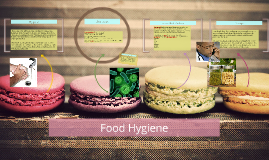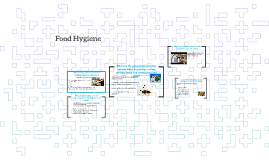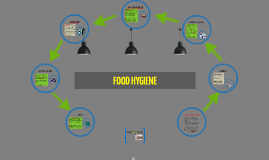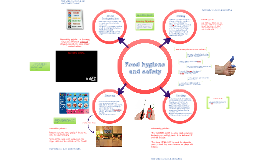FOOD HYGIENE
Transcript: FOOD HYGIENE Different colored chopping boards should be used for different foods. this is to prevent cross contamination. Red for raw meat. Blue for seafood ect. Yellow for cooked meat. Green for fruit and salad. Brown for vegetables. And White for bread. Food premise must be kept in good,clean condition. The layout of the premise must have adequate design, construction and size. This should permit adequate maintenance and cleaning areas, avoid air born bacteria, permit good food handling, and prevent pests and food contamination. Suitable temperature controlled handling and storage areas must be monitored and well ventilated. There must be an adequate amount of toilets away form prep areas. There must be washbasins with hot and cold water, and materials for drying hands hygienically. Adequate lighting must be present. Where necessary, separate changing rooms should be provided. ESCHERICHIA COLI (E. COLI) SALMONELLA LISTERIA EQUIPMENT E. Coli can live in the intestine of perfectly healthy human beings. Most varieties are harmless, but some strains can cause diarrhea, severe abdominal pains and sickness. Raw vegetables and undercooked ground beef are the worst carriers of the bacteria. healthy adult will usually recover in under a week, but in young children it can cause Hemolytic Uremic Syndrome (H.U.S) a deadly form of kidney failure. most symptoms develop within 3-4 days, but that can range from 1-10 days. Cleanliness SALMONELLA BACTERIA In all kitchens the correct equipment must be used to prepare the food properly and keep it safe. Fridges- All fridges should be between 2 and 5 degrees. Any persihable foods should be kept and covered in the fridge. Raw meant should ALWAYS be at the bottom. This is to prevent meat juices contaminating other foods Freezers- ALL freezers should be below -18 degrees. This not only keeps any bacteria dormant, but also prevents food defrosting. CAMPYLOBACTER BACTERIA STAPH ' BACTERIA BASIC HYGIENE In most people listeriosis causes only mild symptoms. Such as high temperature or vomiting. Symptoms usually last for about three days and do not need treating. However if the disease spreads it can cause extreme diseases such as meningitis. Signs of extreme listeria can be a stiff neck, headaches, and tremors. The disease is found in foods such as soft cheese, pre-packed sandwiches, smoked salmon and cooked sliced meats. It is EXTREMELY dangerous in pregnant women. Salmonella are a group of bacteria that causes food poisoning, which causes Gastroenteritis (an infection of the gut that causes diarrhea and vomiting). Symptoms develop 12-74 hours after infection and can last for up to 7 days, putting the patient at risk of dehydration. Salmonella can be found in the gut of many farm animals and pets, but is mostly from poultry. This means that Salmonella can also infect other things such as eggs and even milk. Campylobacter is a disease that causes severe cramps, diarrhea, and a fever. It usually last about a week with symptoms developing within 4-5 days. In people with weakened immune systems it can spread to the bloodstream and be potentially fatal. This disease is often associated with unpasteurized milk as well as poultry, and water. It only takes just 500 organism to make a person sick, and can be contracted from one drop of anything contaminated. Clostridium is a spore born bacteria, found in many environmental sources as well as in humans. It is more commonly found on raw meat and poultry. It prefers conditions with little or no oxygen and can multiply rapidly. People that are infected develop symptoms of stomach cramps and diarrhea within 6- 24 hours. Serious cases can last up to two weeks. FOOD HYGIENE LAWS E. COLI BACTERIA LISTERIA BACTERIA FOOD POISONING CAMPYLOBACTER STAPHYLOCOCCUS AUREUS CLOSTRIDIUM PERFRINIGENS CLOSTRIDIUM BACTERIA Food poisoning is more serious than it sounds. If left untreated it can be potentially fatal, and it is much worse in young children, the elderly, and the ill. The important thing to understand is that it is 100% preventable, simply by treating food correctly. All food premises should have an embedded safety plan. If they don't and you become ill, they can be sued on the grounds that you have become ill due to the incompetence of somebody else. Hands- You must always wash you hands with soap and water. You should also wash your hands whenever you have been to the toilet, sneezed, coughed or blown your nose. Hair and Apron- When handling food, hair must always be tied back. As well as this a clean apron must always be worn, and if it becomes dirty it must be replaced or washed. Staph' as the disease is well know as: is a disease that can go from one extreme to another. Some patients will only experience annoying boils or rashes, however it can cause blood poisoning (septicemia) and endocarditis (infection of the lining of the heart), both can be fatal. However someone can become infected and never experience symptoms. For those that do it

















